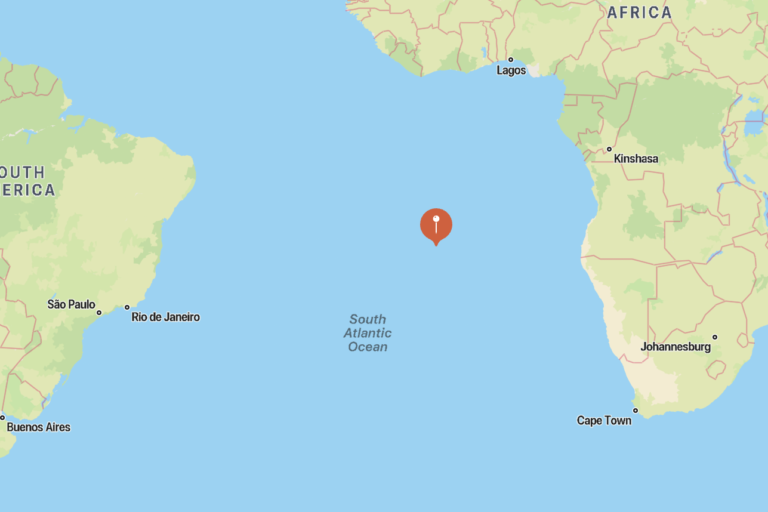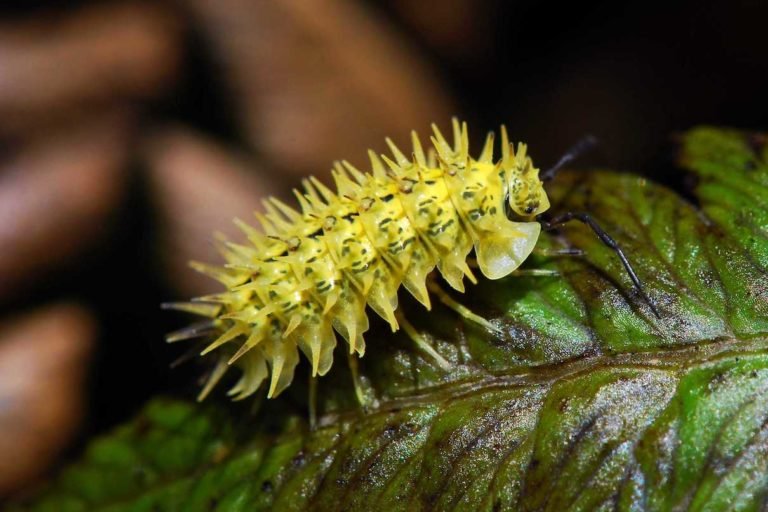- Saint Helena Island’s spiky yellow woodlouse is a striking, critically endangered isopod that lives on tree ferns and black cabbage trees, high up in the peaks of Saint Helena’s cloud forests.
- The flax industry destroyed and fragmented most of the forests that the woodlouse depends on. Invasive species and climate change continue to affect them.
- The population of spiky yellow woodlouse is estimated to be at 980 individuals, so the Saint Helena National Trust is working to restore the forests on the island by clearing away the flax plants that were left behind and replanting more native flora.
- This article is a commentary. The views expressed are those of the author, not necessarily of Mongabay.
In the middle of the South Atlantic Ocean lies a remote tropical island known as Saint Helena. It is a United Kingdom territory that is 1,200 miles (1,950 km) west of the southwestern coast of Africa.
“St Helena holds over 30% (502 known native/endemics) of the total endemic diversity of the UK and its overseas territories. There are 45 native plant species and more than 400 native invertebrates,” Martina Peters, head of conservation at the Saint Helena National Trust, explains.
The Saint Helena National Trust was founded in 2002 with the purpose of preserving Saint Helena’s environment, wildlife, and cultural heritage. It is only here on this island that one of the most peculiar bugs resides, the spiky yellow woodlouse. They are a species of isopod which are commonly referred to as roly-polies or woodlice, they are not insects but in fact crustaceans. They are more closely related to lobsters and crabs than insects.
The spiky yellow woodlouse is one of the rarest and most endangered isopods and their appearance lives up to the name: a spiky yellow woodlouse is bright yellow with various spikes protruding from the exoskeleton. The spikes are believed to be a form of defense against predators, however, this has not been proven. The spiky yellow woodlouse lives on black cabbage trees high up in the peaks of St. Helena’s cloud forest.
To understand why the spiky yellow woodlouse is critically endangered we must first look at history of the island. From 1907 to 1966, the flax industry was the driving force of Saint Helena’s economy, but today it no longer exists. The New Zealand flax (Phorium tenax), was introduced to the island for the purpose of growing, processing, and exporting flax. Flax was used to make rope and string both locally and for exporting. The demand for rope during World War I fueled the flax industry. Many flax mills were constructed on the island. When World War 2 occurred, Saint Helena’s economy also profited from the increased demand for rope.
Flax prices continued to climb even after the world wars. At the industry’s peak, 3,000 acres of the island was covered in flax and 300 to 400 were working directly in the flax industry, usually working 50 hours per week. However, the flax industry eventually declined due to competition from synthetic fibers and expensive shipping costs. The flax industry on the island collapsed, when the British Post Office switched to synthetic fibers in 1965. A year later, all of Saint Helena’s flax mills were closed down, with the last one closing in 1966.
As a result, the island was left covered with neglected flax plants that have no purpose. Unfortunately, the New Zealand flax is not an easy plant to get rid of. They can survive droughts, and their roots may extend as wide and deep as the height of the plant itself, which can grow 6 to 10 feet tall (2 to 3 meters).

However, flax clearing projects have been undertaken to grow back the forests, since many of the island’s plants and animals are endangered due to the habitat destruction by the flax industry. Some species have even gone extinct, such as the Saint Helena giant earwig. It was the largest earwig species with a body length ranging from 1.42 to 2.13 (36 to 55 mm). It has been called “Dodo of the earwigs,” because it was only native to the island and went extinct from habitat loss and predation by invasive species. The Saint Helena giant earwig was last seen alive in 1967. “The remnants of the native biodiversity are now struggling to survive in tiny fragments. Sadly, this has led to extinction for some invertebrates such as the giant earwig, giant ground beetle, and St Helena darter which have become globally extinct within the memory spans of long-term residents living on the island,” Peters explains.
Many of the forests that spiky yellow woodlouse inhabited were cleared to make timber, space for livestock, and for invasive flax farming. Climate change is also reducing the size of their habitats as droughts become more frequent. There were water shortages in 2013, 2016 and 2019.
It was once thought that were only 100 spiky yellow woodlouse left, in a small area of black cabbage trees. However, more surveys were conducted and more populations were found. The Spiky yellow woodlouse population is now believed to be closer to 1,000.
“The population estimate for spiky yellow woodlouse is 980 individuals. If habitats continue to disappear due to invasive species and wider effect of climate change then populations will continue to decline,” Peters says. Spiky yellow woodlouse also glow under UV light which makes it easier for researchers to find them at night.

The black cabbage trees which they live on are also endangered due to habitat destruction. According to Peters, there is a disease that is affecting black cabbage trees in the cloud forest, so research is being done to combat this (Martina Peters, personal communication, October 1 2021). Spiky yellow woodlouse have been found living on other non-native plants too. Unlike regular isopods who live on the ground and feed on dead or decaying matter (such as leaves, stems, roots, and even poop), spiky yellow woodlouse live on tree ferns and are believed to feed on the spores of these tree ferns, but further research is needed to test this theory.
There was a project that focused on conservation for the species entitled “Conservation of the spiky yellow woodlouse and black cabbage tree woodland on St Helena” which ran for three years from April 2014 to March 2017. The project managed to successfully clear pasture grasses outside the forest, installed windbreaks to protect new plants, collected seeds and propagate 5,000 endemic plants and 600 endemic trees, carried out assessments on restorations for the cloud forest, designated protocols for regularly monitoring micro-climates through the installation of regular stations, and conducted population surveys of spiky yellow woodlouse at different sites.
According to the trust’s Peters, there were plans to introduce the animals into a captive breeding program, however these plans were altered when more spiky yellow woodlouse populations were discovered. They instead they chose focus more on, “on increasing the understanding of habitat” and “ecological requirements of the species” through observations, so the captive breeding program ultimately was not carried out.
The spiky yellow woodlouse is unique because it is only found on Saint Helena, and it deserves more attention than it gets. More work is being done to ensure that these little yellow critters don’t disappear and become a distant memory.
Nick D’Onofrio has always been fascinated by nature, and his passion for wildlife grew through the critters discovered in his backyard as a child, which led to interests in photography, hiking, the outdoors, writing, and travel.
Citations:
“The Flax Industry . St Helena Island.” StHelenaIsland.info, 21 Feb. 2016, https://sthelenaisland.info/the-flax-industry
“Star Objects of Our Collection – Dodo of the Earwigs.” Entomology Manchester, 5 May 2016, https://entomologymanchester.wordpress.com/2010/04/30/star-objects-of-our-collection-dodo-of-the-earwigs
See related news of critically endangered species:
In the Mekong’s murky depths, giants abound, new expedition finds












